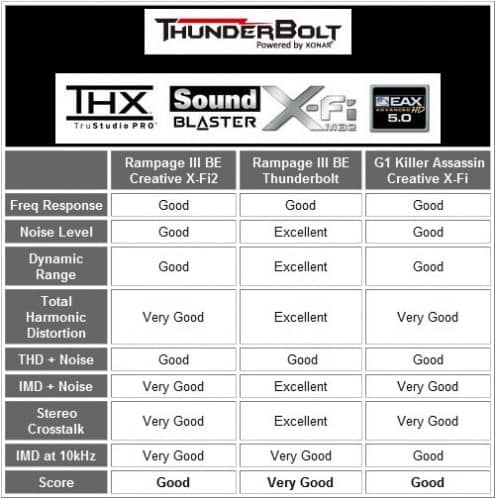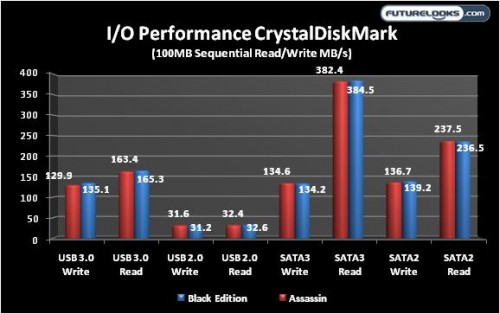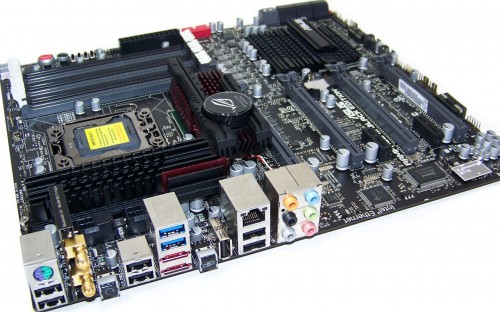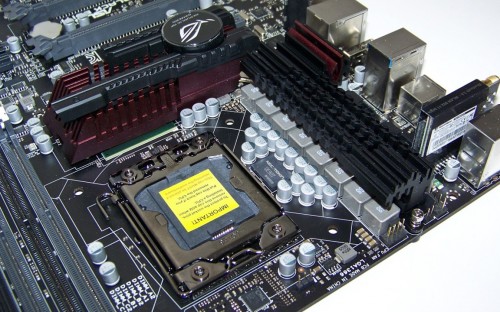Creative X-Fi vs Creative X-Fi
Again, this test comes down to quality of audio due to implementation. Engineering variables like trace routes and component placement drastically effect audio performance. Using RightMarkAudio, I tested the integrated X-Fi audio processor and Thunderbolt card which includes ASUS Xonar audio.
Regardless of implementation, both boards’ X-Fi produced admirable audio performance and quality. You can’t tell the difference playing a game on either platform at typical volumes. But, crank up the audio and you can tell the Assassin offers slightly richer, better volume especially through the front panel audio via its left and right channel amplifiers. On both, audio is also very clean without the typical hum/interference that can filter through when running the front audio jacks.
Things changed when testing through the discrete Thunderbolt card. Granted, the gaming audio with the Creative X-Fi is far superior to any integrated Realtek or VIA audio but the Xonar’s music and voice quality was surprising to say the least. The musicality was definitely something you don’t get with standard run of the mill integrated solutions.
IO and SATA Testing – SANDRA Network and CrystalDiskMark
We typically test IO performance mainly to make sure you folks aren’t getting shorted performance on a platform you spent your hard earned money. Keep in mind that most add-on or peripheral PCI/PCIE cards often out perform integrated IO components. This time around we’re testing SATA performance with a SATA3 SSD given these are high performance motherboards.
The only interesting result seems to come in the form of USB 3.0 testing yet again. Both platforms use Renesas controllers (formerly known as NEC). The Rampage III Black Edition seems to offer better implementation and faster performance. It may not seem like much, but we take what we can get. It may help that the enclosure we use has an ASMedia chip onboard which is a division of ASUS themselves.
Is the Rampage III Black Edition the Best X58 Gaming Motherboard?
The ASUS Rampage III Black Edition is a far more aggressive overclocking platform than the GIGABYTE G1.Killer Assassin. This makes sense given that the Assassin offers only a 16 Phase VRM while their best overclocking models utilizing 20 or more phases. The Rampage II Black Edition offers a much more sophisticated VRM that has to appease high end liquid nitrogen overclocks. However, stock performance between the two is very close meaning most users aren’t going to notice the difference. Where the G1.Killer Assassin will appeal to more mainstream gamers, the Rampage III Black Edition takes it up a notch to try to please overclockers as well.
The two platforms battle for audio supremacy through their featured Creative X-Fi audio. The G1.Killer Assassin and Rampage III Black Edition will rock any gamers earlobes off as they both offer a proper headphone amplifier onboard. However, the Rampage III Black Edition brings the Thunderbolt Xonar card to the table offering impressive high quality stereo performance. Music is really a joyous experience. Plus, the Rampage III Black Edition does offer WiFi and Bluetooth connectivity whereas the G1.Killer Assassin does not. The software and accessory bundle is without question another bonus in favor of the Rampage III Black Edition. There’s tons of extras including ASUS bundled software which is always a nice feature to have for getting the most out of your system.
Ultimately, answering the question of “which one” really depends on the user. Do you want high-end overclocking, tweaking and the ROG board design? Or are you less likely to get your overclock and more likely to spend most of your time gaming rather than tweaking? GIGABYTE focused the G1.Killer Assassin more towards gamers who value stable gaming performance over tweaking while ASUS tries to appease both markets with one board. There is a huge gap in pricing though.
Today, the GIGABYTE is well over $100 – 150 less in some markets and once you weigh that in, the Rampage III Black Edition really becomes the premium board that it was built to be without apology. If you love to tweak and can’t leave any settings alone, spend the extra money for the Rampage III Black Edition. It’s the perfect Swan Song for the mighty X58 and should help LGA1366 socket users hold out just a bit longer against its Z68 and X79 siblings.
Pros
- High end overclocking performance and stability
- Republic of Gamers reputation and design
- Great accessories and software bundle
- Maximum Killer, WiFi and Bluetooth connectivity
- Dual BIOS chips for plenty of OC profiles
- Thunderbolt Killer-Xonar combo card
Cons
- Time for a new ROG theme?
- Premium price for premium product
Overall Rating: 9.0 / 10.0

Help Us Improve Our Reviews By Leaving a Comment Below





